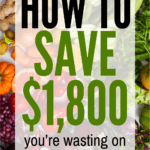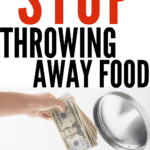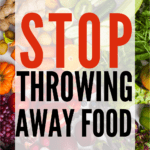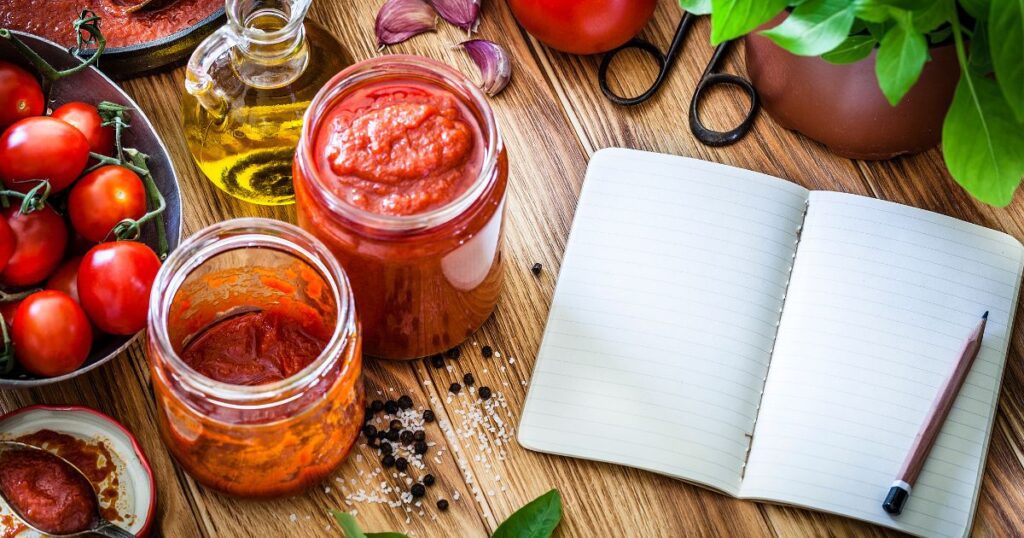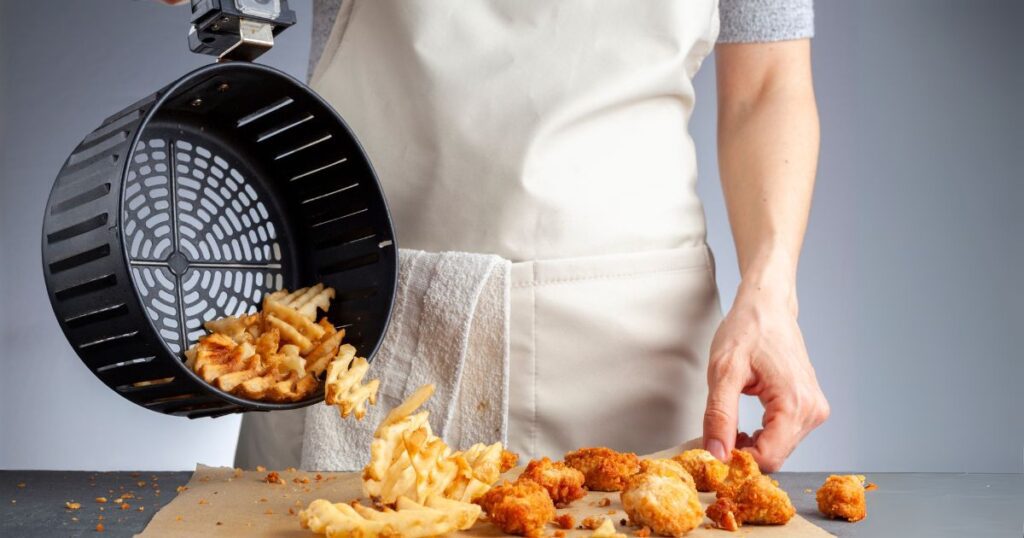Looking to reduce food waste? Smart. Household food waste accounts for up to 50% of all food wasted in the US. An average of six pounds of food are wasted per week per household. If you’ve been inside a grocery store in the last few years, I can see you wincing right now. That’s a lot of money!
How much? The USDA estimates that the average family loses $1,500 per year to uneaten food. However, they’ve been using that statistic since at least 2020, and given recent food cost inflation, I estimate that this is now at least $1,800 per year.
That waste hurts your wallet – and it hurts the planet, too.
So, how can we actually reduce and prevent food waste?
We’re going to walk through a handful of straightforward changes you can make in your home. I’ll also share a template I created for my household to plan our way to less food waste.
The problems with food waste
As mentioned above, when you waste food in your kitchen, you waste money. With 11% of disposable income currently being spent on food – the highest it’s been in 30 years – any way you can reign in that cost and divert the wasted money elsewhere is impactful.
On a broader scale, wasted food represents the end-product of the system that created it, which encompasses labor, money, water, land, and energy that were used to produce, process, transport, and store the food. Try to hold all of that in your mind as you turn to look at those wilted greens or tub of yogurt in your trash can. Could it really all be for nothing? I feel icky and wrong when I think about it like that. It spurs me into action.
Additionally, food is the largest category of material in municipal landfills. Food waste in landfills emits methane, a greenhouse gas that contributes to global warming. In fact, municipal landfills are the third-largest source of human-related methane emissions in the US, according to the EPA.
Why do we waste so much food?
So what gives? Why are we wasting so much food in our homes? There’s a couple of reasons. You might:
- Buy more than you need due to not having a good handle on what you actually use, oversized servings and containers in grocery stores, not having a plan for what you’re going eat through the week or not sticking to your shopping list.
- Throw away edible leftovers because you cooked too much, didn’t have a plan for when to eat them, or didn’t find them appetizing.
- Throw away food based on labels that list a confusing mix of sell-by, best-by, and use-by dates.
- Throw away items that have gone bad, which could be because you stored them in a way that didn’t maximize their freshness, or could be because you didn’t eat them in time for the same reasons above.
Ways to prevent and reduce food waste in your home
As you read through the sources of waste above, do some self-reflection. Which ones apply to you? How do you think food gets wasted in your home?
Now, let’s take those gaps between the food you buy and the food you eat, and make an action plan. There’s little that can’t be solved by having a good plan (that’s what we’re all about around here).
How to only buy what you need
Let’s start with the inputs to your kitchen: how do you only buy the food you will actually eat? My answer: have a ✨food management system✨. This can be something easy and straightforward, but I do think it’s important to consider this a new system you’re implementing. That makes it clear that you’re making a change so you can focus on making it successful.
Your system should incorporate:
- A kitchen inventory, particularly of shelf-stable items and items you don’t use often or are aiming to use up.
- A firm shopping list – add everything you need to the list, and then follow it strictly in the store. Ideally, you should add to your list throughout the week and then in a meal-planning session.
- A meal plan that accommodates food you already have on hand – what are you and your family going to eat for breakfast, lunch, dinner, and snacks this week? Make sure to reference what food you currently have in the kitchen and work it into your plan. Also plan for leftover nights, or if that’s unappealing to you then rebrand it to “prepped meal” nights or “smorgasboard” nights. Additionally, leave space in your plan to freestyle with whatever uncooked ingredients are left. I typically plan 4-5 nights of cooking, one night of a snack dinner with a movie, and 1-2 nights of using up whatever’s left in the kitchen, whether it’s already cooked or an ingredient. You can also build in efficiencies, like having the same side dishes with different main dishes.
- A way to track upcoming expiration dates of food you go through slowly or have on hand for emergencies.
I’ve created a Notion template with this system ready-made for you – you can get a copy here. Here’s a walkthrough of how it works:
Other physical changes you can make in your kitchen include:
- Rearranging your refrigerator and counter space – one simple change we made in my household was to designate a shelf in the fridge for leftovers and other food that needs to be eaten ASAP. We put the oldest items in the front, and grab that for lunch. When we add new leftovers, they go on that shelf but behind anything else that is there, and only get moved forward when everything in front is gone.
- A meal plan on the fridge. Some people also include a handwritten list of items that need to be used up (although I prefer to manage this digitally). One tip that might work for you is to put your grocery receipts on the fridge. As you use things up, cross them off the receipt (as well as any non-food items or those for long-term use like flour and oil).
How to minimize food waste by throwing less away
Now let’s look at the outputs from your kitchen, with a goal of minimizing them. To throw away less food:
- Learn what food date labels mean – you may be surprised to learn that food dates are not required by federal law, and that they are provided to help decide if food is of best quality, not necessarily whether the food is safe (with an exception for infant formula). The common “best if used by” label indicates when a product will be of best flavor or quality, and does not indicate safety. You can and should examine food for signs of spoilage yourself, and eat it if it seems fine.
- Store food properly – for example, I started keeping berries in glass jars and they last a week or more than they do in plastic containers. Greens and herbs last longer when stored with a paper or kitchen towel to absorb excess moisture. The FoodKeeper app from the USDA provides more guidance for almost anything you want to keep fresh.
- Learn how to use more of your produce – there are actually cookbooks that focus on this very topic. One I enjoy is Kansha by Elizabeth Andoh, which showcases the Japanese concept of gratitude for nature’s gifts and focuses on avoiding waste by using as much of the plants we eat as possible.
- Use leftover bits of food and save for an “anything goes” or “kitchen sink” meal. Some favorite meals that can easily incorporate whatever you have on hand include soup, stir fry or fried rice, pasta, vegetable pancakes, rice bowls, sandwiches, casserole, french toast made with assorted ends of bread, smoothies, and breads or muffins with leftover fruit. Some folks give this a fun name like “freezer diving”.
- Freeze vegetable and herb scraps in a bag, and when the bag gets full, make homemade vegetable broth. I do this every week or two.
- Pickle leftover vegetables to extend their lifespan.
- Freeze the unexpected. I freeze all kinds of bread in my house. You can also freeze avocados, butter, eggs, fruit, milk, rice, cake, broth, lemon or orange slices for cooking, grapes for a cool snack, cheese, fresh ginger and garlic, leafy greens, and more.
- After a gathering or party, have containers ready for guests to take any leftovers home, so your fridge isn’t overwhelmed. With close friends, I even encourage them to bring their own storage containers for leftovers!
- Give away food that’s still good to eat, especially packaged food. This could be in the form of a donation to a food pantry. You could also join a Buy Nothing group in your area – mine is on Facebook – and post anything you want to give away to one of your neighbors. Food always gets snapped up quickly.
- Start composting – the last line of defense between your food and the landfill. Composted food produces relatively less methane. Learn how to get started from the EPA.
Let’s get saving!
What’s your favorite tip to prevent food waste?
Up next: make more eco-friendly and sustainable choices. Here’s our eco-friendly school supply shopping guide.


